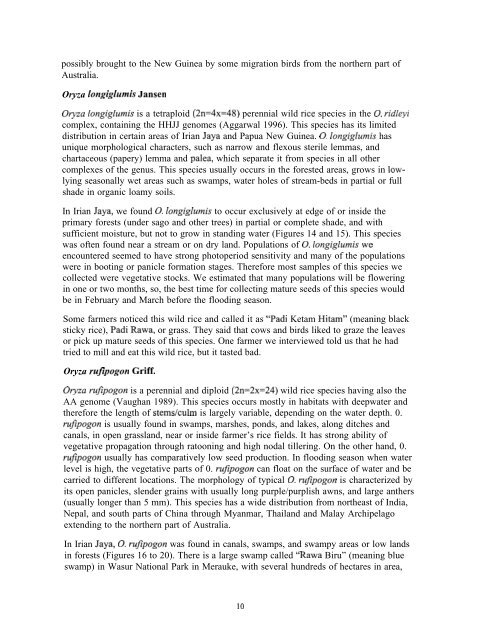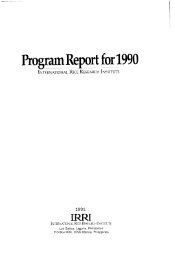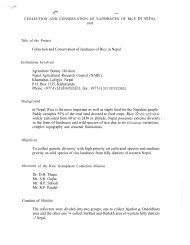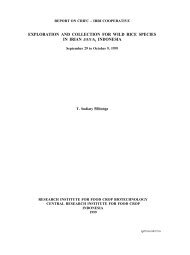Appendix 1 - IRRI
Appendix 1 - IRRI
Appendix 1 - IRRI
You also want an ePaper? Increase the reach of your titles
YUMPU automatically turns print PDFs into web optimized ePapers that Google loves.
possibly brought to the New Guinea by some migration birds from the northern part of<br />
Australia.<br />
Oryza longiglumis Jansen<br />
Oryza Zongiglumis is a tetraploid (2n=4x=48) perennial wild rice species in the 0. ridleyi<br />
complex, containing the HHJJ genomes (Aggarwal 1996). This species has its limited<br />
distribution in certain areas of Irian Jaya and Papua New Guinea. 0. Zongiglumis has<br />
unique morphological characters, such as narrow and flexous sterile lemmas, and<br />
chartaceous (papery) lemma and palea, which separate it from species in all other<br />
complexes of the genus. This species usually occurs in the forested areas, grows in lowlying<br />
seasonally wet areas such as swamps, water holes of stream-beds in partial or full<br />
shade in organic loamy soils.<br />
In Irian Jaya, we found 0. Zongiglumis to occur exclusively at edge of or inside the<br />
primary forests (under sago and other trees) in partial or complete shade, and with<br />
sufficient moisture, but not to grow in standing water (Figures 14 and 15). This species<br />
was often found near a stream or on dry land. Populations of 0. ZongigZumis we<br />
encountered seemed to have strong photoperiod sensitivity and many of the populations<br />
were in booting or panicle formation stages. Therefore most samples of this species we<br />
collected were vegetative stocks. We estimated that many populations will be flowering<br />
in one or two months, so, the best time for collecting mature seeds of this species would<br />
be in February and March before the flooding season.<br />
Some farmers noticed this wild rice and called it as “Padi Ketam Hitam” (meaning black<br />
sticky rice), Padi Rawa, or grass. They said that cows and birds liked to graze the leaves<br />
or pick up mature seeds of this species. One farmer we interviewed told us that he had<br />
tried to mill and eat this wild rice, but it tasted bad.<br />
Oryza rufipogon Griff.<br />
Oryza rujipogon is a perennial and diploid (2n=2x=24) wild rice species having also the<br />
AA genome (Vaughan 1989). This species occurs mostly in habitats with deepwater and<br />
therefore the length of stems/culm is largely variable, depending on the water depth. 0.<br />
rujpogon is usually found in swamps, marshes, ponds, and lakes, along ditches and<br />
canals, in open grassland, near or inside farmer’s rice fields. It has strong ability of<br />
vegetative propagation through ratooning and high nodal tillering. On the other hand, 0.<br />
ru$pogon usually has comparatively low seed production. In flooding season when water<br />
level is high, the vegetative parts of 0. rufipogon can float on the surface of water and be<br />
carried to different locations. The morphology of typical 0. rufipogon is characterized by<br />
its open panicles, slender grains with usually long purple/purplish awns, and large anthers<br />
(usually longer than 5 mm). This species has a wide distribution from northeast of India,<br />
Nepal, and south parts of China through Myanmar, Thailand and Malay Archipelago<br />
extending to the northern part of Australia.<br />
In Irian Jaya, 0. rufipogon was found in canals, swamps, and swampy areas or low lands<br />
in forests (Figures 16 to 20). There is a large swamp called “Rawa Biru” (meaning blue<br />
swamp) in Wasur National Park in Merauke, with several hundreds of hectares in area,<br />
10





